Dryland Sleddog Sports
Dryland sled dog racing is sled dog races with no snow on the ground. This sport features various breeds of dogs bred to run while pulling wheeled carts, bikes or just run with the owner.
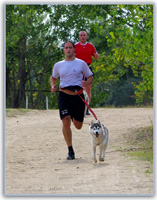 |
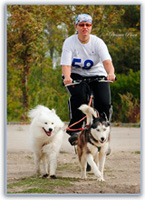 |
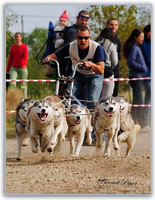 |
| Canicross | Bikejöring | Carting |
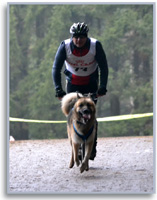 |
||
| Scooter |
Original Sleddog Sports
Original sled dog racing is sled dog races with snow on the ground. This sport features various breeds of dogs bred to run while pulling sleds and people on skiis.
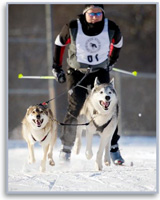 |
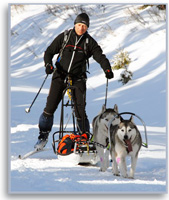 |
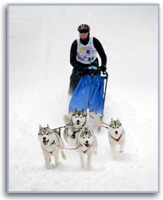 |
| Skijöring | Pulka | Sledding |
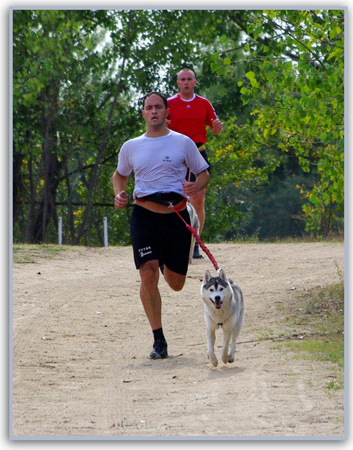
Cani-cross is the sport of cross-country running while hitched to a dog.
Originating in Europe as off-season training for the mushing (sledding) community, it has become popular as a stand-alone sport all over Europe.
Canicross can be run with one or two dogs, always attached to the runner. The runner typically wears a waist belt, the dog a harness, and the two are joined by a bungee cord or elastic line that reduces shock to both human and dog when the dog pulls.
Originally canicross dogs were of sledding or primitive types such as the husky or malamute but now all breeds have begun taking part including cross breeds, small terrier breeds to large breeds such as rottweilers and standard poodles. Not only can all breeds run but people of all ages and abilities can take part. Including children and the disabled such as the visually impaired. Some breeds are very well suited to not only running and pulling but running at steady pace over a long distance. Cani-cross is now not only a great way for the runner to keep fit, but great for the dogs too. It encourages people and their dogs to take part in outdoor activity and meet other like minded individuals.
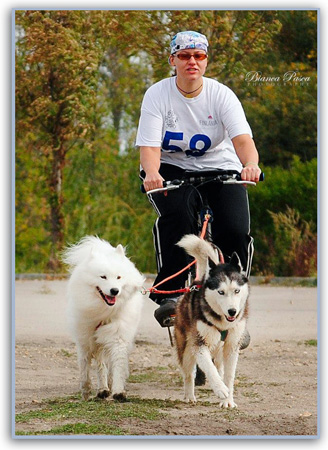
It is a recreation or sport where a harnessed dog or team of dogs attached to a towline have to pull and run ahead of a cyclist. Bikejoring is a non snow season (dryland) activity.
Bikejoring is also sometimes used to train racing sled-dogs out of season.
Although any breed (or non-breed) of dog can be used, American Pit Bulls, Siberian Huskies, Samoyeds, Malamutes, Alaskan Huskies, Sled Hounds and Pointers are probably the most popular breeds for bikejoring. However, any type of dog that can be taught to pull, run, and to accept a few lead dog commands can be used to bikejor. Bikejoring and dog scootering are activities that can be beneficial to the health and fitness of dogs. It can be used to provide dogs with work and exercise, without letting them run off leash and endangering wild-life or livestock.
The dog or dogs are fitted with harnesses suitable for pulling and running in, such as x-back harnesses. The harnesses are normally attached to a gang line (if more than one dog is being used), and a bungee towline, which clips to the front of the bicycle. Many bikejorers use bayonets, antennas, or plastic pipes to suspend the towline above the front wheel, and to prevent it from tangling between the wheel and forks. If two dogs are employed on a gang line, they are sometimes also attached to each other by a neckline between their collars. Bikejoring can be fun but has its dangers. The dogs may be distracted by wild-life.

Carting is a dog sport or activity in which a dog (usually a large breed) pulls a Dogcart filled with supplies, such as farm goods or firewood, but sometimes pulling people. Carting as a sport is also known as dryland mushing and is practiced all around the world, often to keep winter sled dogs in competition form during the off-season.
Dryland mushing is distinguished from sulky driving in that the cart, or dryland rig, is attached to the dog in the same manner as a team to a sled. The cart has three or four wheels, with the driver either sitting or standing, depending on the cart construction.

Scooters are often used instead of bicycles, as they are easier to dismount if the dogs decide to give chase to an animal. Although exactly the same as bikejoring except that a scooter is used to carry the musher instead of a bicycle, this activity is known as dog scootering rather than as bikejoring. The musher can still assist the dog/s by kicking at the trail, rather than by pedalling. The scooters used are usually rugged enough for carrying an adult cross country. Some scooters are manufactured specifically for dog-scootering.
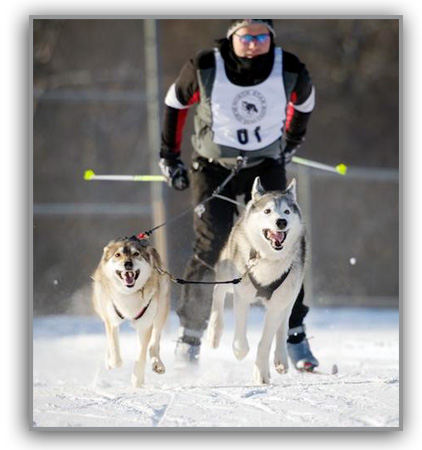
Skijoring with a dog is a sport in which a dog (or dogs), assist a cross-country skier. One to three dogs are commonly used. The cross-country skier provides power with skis and poles, and the dog adds additional power by running and pulling. The skier wears a skijoring harness, the dog wears a sled dog harness, and the two are connected by a length of rope. There are no reins or other signaling devices to control the dog: The dog must be motivated by its own desire to run, and respond to the owner's voice for direction.
Many breeds of dog participate in skijoring. The only prerequisite is a desire to run down a trail and pull, which is innate in many dogs. Small dogs (less than 35 pounds) are rarely seen skijoring, because they do not greatly assist the skier; however, since the skier can provide as much power as is required to travel, any enthusiastic dog can participate. Athletic dogs such as Pointers, Setters and herding breeds take to skijoring with glee, as do the northern breeds, such as Siberian and Alaskan Huskies, Malamutes, Samoyeds, and Inuit dogs; however, any energetic dog is capable of enjoying this sport. Golden Retrievers, Giant Schnauzers, Labs, and many cross-breeds are seen in harness. Pulling breeds work well also such as American Bull Terriers, Staffordshire Terriers, American bull dogs, and mastiffs.
The sport is practiced recreationally, and competitively, both for long distance travel and for short (sprint) distances.
The skijoring belt worn by the skier is a wide waistband which is clipped around the skier's waist, and which may include leg loops to keep it in position. Rock Climbing harnesses are also commonly used as skijoring belts.
The sled dog harness can be any of the several types of dog harness commonly used for dogsled racing.
The skijoring line is usually at least 1.5 metres (8 feet) long. A longer line is used for a three-dog team. A section of bungee cord is often incorporated into the line to absorb the impact of the dog's forward motion or a quick stop by the skier. Special quick-release hitches or hooks are available, used so that the skijorer may unhook the dog's lead rapidly.
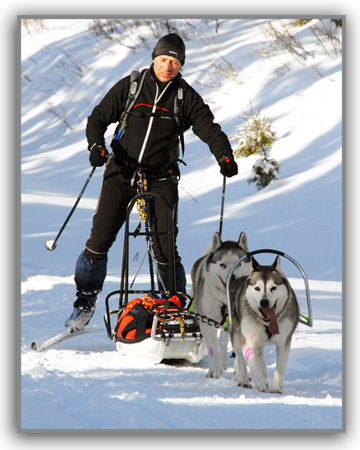
A pulk (from Finnish pulkka) is a Nordic short, low-slung small toboggan used in sport or for transport, pulled by a dog.
The name of the sport is pulka. The sled can be used to carry supplies such as a tent or food, or transport a child or other person.
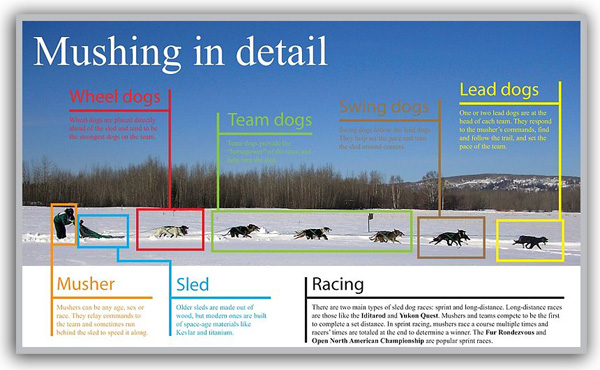
Racing sleddogs wear individual harnesses to which "tuglines" are snapped, pulling from a loop near the root of the tail. The dogs are hooked in pairs, their tuglines being attached in turn to a central "gangline". The lines usually include short "necklines" snapped to each dog's collar, just to keep the dogs in proper position. It is unusual ever to see more than 22 dogs hooked at once in a racing team, and that number is usually seen only on the first day of the most highly competitive sprint events. Dogs may be omitted from the teams on subsequent days, but none may be added.
The most famous long-distance race is the Iditarod Trail Sled Dog Race. Also known as the "Last Great Race on Earth", the Iditarod is roughly 1000 miles of some of the roughest and most beautiful terrain in the world. The race consists of fierce mountains, frozen rivers, thick forests, and desolate tundras. Each team of 12–16 dogs must go from Anchorage all the way to Nome.
Although each musher has different strategies, each team must have certain pieces of equipment, such as an arctic parka, an ax, snowshoes, and boots for each dog's feet to protect against cutting ice and hard packed snow injuries.

